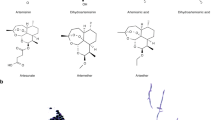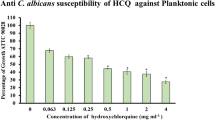Abstract
Opportunistic oral infections caused by Candida albicans are frequent problems in immunocompromised patients. Management of such infections is limited due to the low number of antifungal drugs available, their relatively high toxicity and the emergence of antifungal resistance. Given these issues, our investigations have focused on novel derivatives of the antifungal antibiotic Nystatin A1, generated by modifications at the amino group of this molecule. The aims of this study were to evaluate the antifungal effectiveness and host cell toxicity of these new compounds using an in vitro model of oral candidosis based on a reconstituted human oral epithelium (RHOE). Initial studies employing broth microdilution, revealed that against planktonic C. albicans, Nystatin A1 had lower minimal inhibitory concentration than novel derivatives. However, Nystatin A1 was also markedly more toxic against human keratinocyte cells. Interestingly, using live/dead staining to assess C. albicans and tissue cell viability after RHOE infection, Nystatin A1 derivatives were more active against Candida with lower toxicity to epithelial cells than the parent drug. Lactate dehydrogenase activity released by the RHOE indicated a fourfold reduction in tissue damage when certain Nystatin derivatives were used compared with Nystatin A1. Furthermore, compared with Nystatin A1, colonisation of the oral epithelium by C. albicans was notably reduced by the new polyenes. In the absence of antifungal agents, confocal laser scanning microscopy showed that C. albicans extensively invaded the RHOE. However, the presence of the novel derivatives greatly reduced or totally prevented this fungal invasion.









Similar content being viewed by others
References
Farah CS, Ashman RB, Challacombe SJ (2000) Oral candidosis. Clin Dermatol 18:553–562
Joint United Nations Programme on HIV/AIDS (UNAIDS) and World Health Organization (WHO) (2009) AIDS epidemic update: November 2009, Geneva, Switzerland
Petersen PE (2008) Oral cancer prevention and control—the approach of the World Health Organization. Oral Oncol 45:454–460
World Health Organization (2013) Diabetes Programme: fact sheet N°312. http://www.who.int/diabetes/en/. Updated March 2013, Geneva, Switzerland
Mane A, Gaikwad S, Bembalkar S, Risbud A (2012) Increased expression of virulence attributes in oral Candida albicans isolates from human immunodeficiency virus-positive individuals. J Med Microbiol 61:285–290
Davies AN, Brailsford SR, Beighton D (2006) Oral candidosis in patients with advanced cancer. Oral Oncol 42:698–702
Soysa NS, Samaranayake LP, Ellepola ANB (2005) Diabetes mellitus as a contributory factor in oral candidosis. Diabet Med 23:455–459
Zhu W, Filler SG (2010) Interactions of Candida albicans with epithelial cells. Cell Microbiol 12:273–282
Mayer FL, Wilson D, Hube B (2013) Candida albicans pathogenicity mechanisms. Virulence 4:119–128
Samaranayake LP, Keung Leung W, Jin L (2009) Oral mucosal fungal infections. Periodontol 2000 49:39–59
Williams D, Lewis M (2011) Pathogenesis and treatment of oral candidosis. J Oral Microbiol 3:5771
Ellepola ANB, Samaranayake LP (2000) Oral candidal infections and antimycotics. Crit Rev Oral Biol Med 11:172–198
Lewis RE (2011) Current concepts in antifungal pharmacology. Mayo Clin Proc 86:805–817
Wakieć R, Prasad R, Morschhäuser J, Barchiesi F, Borowski E, Milewski S (2007) Voriconazole and multidrug resistance in Candida albicans. Mycoses 50:109–115
Zotchev SB (2003) Polyene macrolide antibiotics and their applications in human therapy. Curr Med Chem 10:211–223
Pierce CG, Lopez-Ribot JL (2013) Candidiasis drug discovery and development: new approaches targeting virulence for discovering and identifying new drugs. Expert Opin Drug Discov 9:1117–1126
Chéron M, Cybulska B, Mazerski J, Grzybowska J, Czerwiński A, Borowski E (1988) Quantitative structure-activity relationships in amphotericin B derivatives. Biochem Pharmacol 37:827–836
Baginski M, Czub J (2009) Amphotericin B and its new derivatives—mode of action. Curr Drug Metab 10:459–469
Volmer AA, Szpilman AM, Carreira EM (2010) Synthesis and biological evaluation of amphotericin B derivatives. Nat Prod Rep 27:1329–1349
Paquet V, Volmer AA, Carreira EM (2008) Synthesis and in vitro biological properties of novel cationic derivatives of amphotericin B. Chemistry 14:2465–2481
Borowski E, Salewska N, Boros-Majewska J, Milewska M, Wysocka M, Milewski S, Składanowski A, Treder A, Sadowska E, Łacka I (2013) Semisynthetic derivatives of Nystatin A1. PCT/EP2013/054621; WO 2013/132014 A1 (12 September 2013)
Schaller M, Schäfer W, Korting HC, Hube B (1998) Differential expression of secreted aspartyl proteinases in a model of human oral candidosis and in patient samples from the oral cavity. Mol Microbiol 29:605–615
Schaller M, Zakikhany K, Naglik JR, Weindl G, Hube B (2006) Models of oral and vaginal candidiasis based on in vitro reconstituted human epithelia. Nat Protoc 1:2767–2773
Falkowski L, Kowszyk-Gindifer Z, Plóciennik Z, Zieliński J, Dahlig H, Golik J, Jakobs E, Kołodziejczyk P, Bylec E, Roślik-Kamińska D, Wagner W, Pawlak J, Borowski E (1980) Salts of N-glycosyl derivatives of polyene macrolides, especially N-methylglucamine salts as well as the method of their preparation. Patent USA 4195172 A
The National Committee for Clinical and Laboratory Standards (2002) Reference Method for Broth Dilution Antifungal Susceptibility Testing of Yeasts; Approved Standard-Second Edition M27-A2. NCCLS, 2002, Wayne, PA, USA
Kim J, Sudbery P (2011) Candida albicans, a major human fungal pathogen. J Microbiol 49:171–177
Dalle F, Wächtler B, L’Ollivier C, Holland G, Bannert N, Wilson D, Labruère C, Bonnin A, Hube B (2010) Cellular interactions of Candida albicans with human oral epithelial cells and enterocytes. Cell Microbiol 12:248–271
Ōmura S (1984) Macrolide Antibiotics: Chemistry, Biology, and Practice. Academic Press, Orlando
Larson JL, Wallace TL, Tyl RW, Marr MC, Mayers CB, Cossum PA (2000) The reproductive and development toxicity of the antifungal drug Nyotran (liposomal Nystatin) in rats and rabbits. Toxicol Sci 53:421–429
Semis R, Polacheck I, Segal E (2010) Nystatin-intralipid preparation: characterization and in vitro activity against yeasts and molds. Mycopathologia 169:333–341
Arikan S, Rex JH (2001) Nystatin LF (Aronex/Abbott). Curr Opin Investig Drugs 2:488–495
Barrat G, Bretagne S (2007) Optimizing efficacy of Amphotericin B through nanomodification. Int J Nanomedicine 2:301–313
Semis R, Kagan S, Berdicevsky I, Polacheck I, Segal E (2013) Mechanism of activity and toxicity of Nystatin-intralipid. Med Mycol 51:422–431
Semis E, Nili SS, Munitz A, Zaslavsky Z, Polacheck I, Segal E (2012) Pharmacokinetics, tissue distribution and immunomodulatory effect of intralipid formulation of Nystatin in mice. J Antimicrob Chemother 67:1716–1721
Brautaset T, Sletta H, Nedal A, Borgos SEF et al (2008) Improved antifungal polyene macrolides via engineering of the Nystatin biosynthetic genes in Streptomyces noursei. Chem Biol 15:1198–1206
Bruheim P, Borgos SE, Tsan P, Stella H, Ellingsen TE, Lancelin JM, Zotchev SB (2004) Chemical diversity of polyene macrolides produced by Streptomyces noursei ATCC 11455 and recombinant strain ERD44 with genetically altered polyketide synthase NysC. Antimicrob Agents Chemother 48:4120–4129
Caffrey P, Aparicio JF, Malpartida F, Zotchev SB (2008) Biosynthesis engineering of polyene macrolides towards generation of improved antifungal and antiparasitic agents. Curr Top Med Chem 8:639–653
Falk R, Domb AJ, Polacheck I (1999) A novel injectable water-soluble amphotericin B-arabinogalactan conjugate. Antimicrob Agents Chemother 43:1975–1981
Szlinder-Richert J, Mazerski J, Cybulska B, Grzybowska J, Borowski E (2001) MFAME, N-methyl-N-D-fructosyl amphotericin B methyl ester, a new amphotericin B derivative of low toxicity: relationship between self-association and effects on red blood cells. Biochim Biophys Acta 1528:15–24
Paquet V, Carreira EM (2006) Significant improvement of antifungal activity of polyene macrolides by bisalkylation of the mycosamine. Org Lett 8:1807–1809
Lewis RE, Viale P (2012) Update on amphotericin B pharmacology and dosing for common systemic mycoses. Curr Fungal Infect Rep 6:349–357
Moharamzadeh K, Colley H, Murdoch C, Haernden V, Chai WL, Brook IM, Thornhill MH, MacNeil S (2012) Tissue-engineered oral mucosa. J Dent Res 91:642–650
Peck Y, Wang DA (2013) Three-dimensionally engineered biomimetic tissue models for in vitro drug evaluation: delivery, efficacy and toxicity. Expert Opin Drug Deliv 10:369–383
Borowski E (2000) Novel approaches in the rational design of antifungal agents of low toxicity. Farmaco 55:206–208
Slisz M, Cybulska B, Mazerski J, Grzybowska J, Borowski E (2004) Studies of the effects of antifungal cationic derivatives of amphotericin B on human erythrocytes. J Antibiot (Tokyo) 57:669–678
Martin R, Wächtler B, Schaller M, Wilson D, Hube B (2011) Host-pathogen interactions and virulence-associated genes during Candida albicans oral infections. Int J Med Microbiol 301:417–422
Legrand P, Romero EA, Cohen BE, Bolard J (1992) Effects of aggregation and solvent on the toxicity of amphotericin B to human erythrocytes. Antimicrob Agents Chemother 36:2518–2522
Davey HM (2011) Life, death, and in-between: meanings and methods in microbiology. Appl Environ Microbiol 77:5571–5576
Seneviratne SJ, Jin L, Samaranayake LP (2008) Biofilm lifestyle of Candida: a mini review. Oral Dis 14:582–590
Williams DW, Kuriyama T, Silva S, Malic S, Lewis MAO (2011) Candida biofilms and oral candidosis: treatment and prevention. Periodontol 55:250–265
Bartie KL, Williams DW, Wilson MJ, Potts AJC, Lewis MAO (2004) Differential invasion of Candida albicans isolates in an in vitro model of oral candidosis. Oral Microbiol Immunol 19:293–296
Malic S, Hill KE, Ralphs JR, Hayes A, Thomas DW, Potts AJ, Williams DW (2007) Characterization of Candida albicans infection of an in vitro oral epithelial model using confocal laser scanning microscopy. Oral Microbiol Immunol 22:188–194
Chandra J, Kuhn DM, Mukherjee PK, Hoyer LL, McCormick T, Ghannoum MA (2001) Biofilm formation by the fungal pathogen Candida albicans: development, architecture, and drug resistance. J Bacteriol 183:5385–5394
Zakikhany K, Naglik JR, Shmidt-Westhausen A, Holland G, Schaller M, Hube B (2007) In vivo transcript profiling of Candida albicans identifies a gene essential for interepithelial dissemination. Cell Microbiol 9:2938–2954
Jacobsen ID, Wilson D, Wächtler B, Brunke S, Naglik JR, Hube B (2012) Candida albicans dimorphism as a therapeutic target. Expert Rev Anti Infect Ther 10:85–93
Silva S, Henriques M, Hayes A, Oliveira R, Azeredo J, Williams DW (2011) Candida glabrata and Candida albicans co-infection of an in vitro oral epithelium. J Oral Pathol Med 40:421–427
Baillie GS, Douglas LJ (1998) Effect of growth rate on resistance of Candida albicans biofilms to antifungal agents. Antimicrob Agents Chemother 42:1900–1905
Chandra J, Mukherjee PK, Leidich SD, Faddoul FF, Hoyer LL, Douglas LJ, Ghannoum MA (2001) Antifungal resistance of candidal biofilms formed on denture acrylic in vitro. J Dent Res 80:903–908
Samaranayake YH, Ye J, Yau JYY, Cheung BPK, Samaranayake LP (2005) In vitro method to study antifungal perfusion in Candida biofilms. J Clin Microbiol 43:818–825
Kuriyama T, Williams DW, Bagg J, Coulter WA, Ready D, Lewis MAO (2005) In vitro susceptibility of oral Candida to seven antifungal agents. Oral Microbiol Immunol 20:349–353
Acknowledgments
We would like to thank Mrs Kath Allsopp for processing and sectioning tissue samples. We are also grateful to Mr Marc Isaacs for his assistance with confocal laser scanning microscopy. The project was financed by the National Science Centre (Poland) based on the Grant no. DEC-2011/01/N/NZ1/05269 (PRELUDIUM: pre-doctoral grant).
Author information
Authors and Affiliations
Corresponding author
Rights and permissions
About this article
Cite this article
Boros-Majewska, J., Salewska, N., Borowski, E. et al. Novel Nystatin A1 derivatives exhibiting low host cell toxicity and antifungal activity in an in vitro model of oral candidosis. Med Microbiol Immunol 203, 341–355 (2014). https://doi.org/10.1007/s00430-014-0343-4
Received:
Accepted:
Published:
Issue Date:
DOI: https://doi.org/10.1007/s00430-014-0343-4




